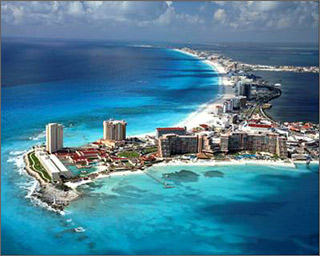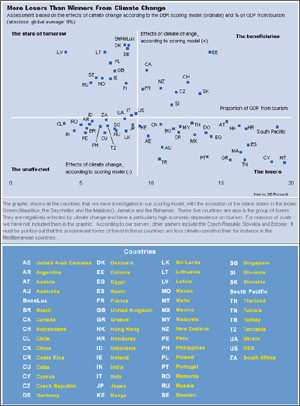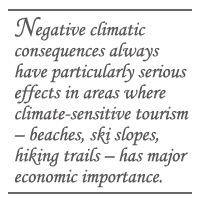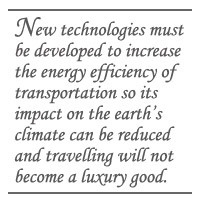Climate Change and Tourism’s Winners and Losers
Climate Change and Tourism’s Winners and Losers

FRANKFURT: Tourism is one industry which has seen a phenomenal growth in an increasingly globalized world. But the forces of globalization have now confronted the industry with a new and serious challenge – that of climate change. It will require a series of long-term of adjustments and is bound to leave some winners and losers.
Ironically, tourism industries will improve in the countries of the northern hemisphere that have contributed the most carbon emissions into the atmosphere leading to climate change. And the tourism industry of countries throughout the southern hemisphere, which have contributed relatively little by way of carbon emissions, will suffer.

The international tourism industry has had to face many challenges in the recent past. These include the terrorist attacks of 11 September 2001, which disturbed air travel, as well as those in tourist destinations such as Bali, Djerba, Morocco and Egypt and in the important tourist cities of Istanbul, Madrid and London. In addition, tourism has been put under pressure by the lung disease Severe Acute Respiratory Syndrome (SARS), the war in the Middle East and years of rising energy prices, which have affected air travel in particular.
In addition to these external shocks, the industry has also been marked by changes on both the supply and demand sides. The travel behavior of many consumers has changed considerably, and some key factors characterizing this change include late bookings, increased price-consciousness, shorter holiday trips, the desire for more flexibility and individuality, and the trend towards special and theme holidays. On the supply side, notable changes include the major success of the low-cost carriers and new distribution channels such as the internet. All things considered, the tourism industry has and will continue to experience turbulent times.

In the face of these difficult conditions, it is astounding that the tourism industry has been able to achieve extremely high growth during the last few years. For instance, according to the World Tourism Organisation (UNWTO), a United Nations agency, between 2000 and 2007 the number of international tourist arrivals increased by an annual average of about 4 percent, to almost 900 million. This suggests that, in the period stated, the dominant drivers of growth at the end of the day were the dynamic global economy, backlog demand in developing and newly industrialised countries, and mankind's inherent desire for individual mobility.
But climate change will impose new challenges to the industry. Unlike natural disasters or terrorist attacks, this is not just a short-term effect that can then be quickly forgotten. Rather, climate change will permanently alter the attraction of some holiday regions and force them to take steps to adapt in the next few decades. Many in the industry anticipate regional and seasonal shifts in both national and international tourist flows during the next few years. As a result, it is also evident that there will be winners and loser from climate change.

To better assess the countries in which the tourism industry will benefit from climate change and those in which negative effects can be expected, Deutsche Bank Research has compared the most important countries in the tourism sector with the aid of a scoring model. This model is based on four parameters, which we have assessed, quantitatively or qualitatively, for all the countries: firstly, direct climatic effects; secondly, substitution effects resulting from climate; thirdly, regulatory burdens, i.e., higher prices of mobility due to fiscal burdens, and consequent geographical substitution effects; and fourthly, the possibility of each country having to adapt to climate effects. The parameters were assessed with different weightings and broken down into subcategories, in order to differentiate better among the countries.
The time horizon is 2030. In a subsequent step we have also identified the countries in which economic reliance on climate-relevant tourism is particularly high, as the overall economic effects are particularly relevant for these.
We can summarize the results of our scoring model in two sentences: The North, which is responsible for a large share of anthropogenic climate change, wins. The South, whose contribution to climate change is still relatively small, loses.
However, it’s reasonable to distinguish between different regions: In Europe, countries bordering the Mediterranean will particularly suffer from climate change. Higher temperatures and water shortages could put off tourists in the high season. This is particularly true for countries in the eastern Mediterranean. In contrast, those that could gain include the Benelux countries, Denmark, Germany and the Baltic countries. France and Italy will be slightly favoured, due to the diversified structure of their tourism offerings.
Canada, New Zealand and the USA are the only three further countries outside Europe whose tourist industries will be on the winning side. The reverse conclusion is that the tourism sector in all countries surveyed in Africa, Latin America and Asia will more or less suffer from climate change in the next few decades.
Poorer countries such as Tanzania, Kenya and the Caribbean have put great hopes on tourism as a driver of development. But our investigation suggests that climate change will impose additional burdens.

Negative climatic consequences always have particularly serious effects in areas where climate-sensitive tourism – beaches, ski slopes, hiking trails – has major economic importance. In Europe this applies to Malta, Cyprus, Spain, Austria and Greece. In the Caribbean, for example, the Bahamas and Jamaica are disproportionately affected; in Asia, Thailand and Malaysia; and in Africa, Tunisia and Morocco. The island states in the South Pacific and the Indian Ocean are particularly reliant on tourism. If tourists stay away from them, the economic setbacks are extremely serious.
Our analysis has shown that the dangers of climate change for the tourism industry reduce the income possibilities, especially for the poor countries, and even increase distributional conflicts. The installation of a local tourism industry has made a significant contribution to economic development in many emerging markets, including the island states in the South Pacific and the Indian Ocean, Mexico and Tunisia. This potential could be reduced in the future not only due to worsening climatic conditions. The increase in the price of mobility in the major source markets for tourism, especially in Europe, could also limit the growth potential of the “new” holiday destinations.

In plain language, if prices for air trips increase, for example, because of their inclusion in emissions trading and if – as a result of that – fewer people travel to faraway destinations, the negative economic impact would be perceptible, especially in the poor countries. This means that measures taken by industrialized countries to reduce their own greenhouse gas emissions and thus their contribution to climate change can cause negative economic effects in other countries. Climate change could enlarge the global imbalance in income distribution.
It’s not an easy task to cope with this challenge. Technological progress is certainly an important lever. New technologies must be developed to substantially increase the energy efficiency of the transportation sector so that its impact on the earth’s climate can be reduced and travelling will not become a luxury good. Governmental support for basic research can be helpful. However, direct transfer payments to the countries most affected by climate change might become necessary in the medium to long term to enable them to adapt to the negative consequences.
Eric Heymann is a senior economist at Deutsche Bank Research in Frankfurt, Germany. Click here to read a 2008 article by Philipp Ehmer and Eric Heymann, “Climate Change and Tourism: Where will the journey lead?” Deutsche Bank Research, Current Issues, Frankfurt, go to www.dbresearch.com.